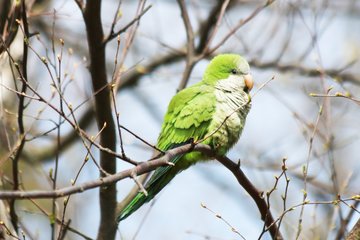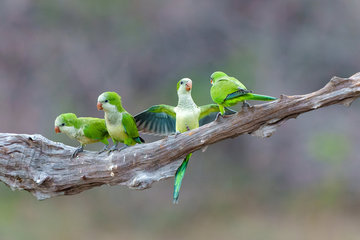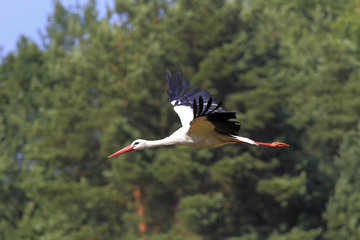Snoozing between the skies and Earth
In humans, even a very short attack of drowsiness while driving can have fatal consequences. Frigatebirds, on the other hand, have no problems snoozing while they cruise through the air. What’s more, they generally get by on very little sleep during their long flights over the open sea, which can last for days. A team of scientists headed by Niels Rattenborg from the Max Planck Institute for Ornithology in Seewiesen has demonstrated, for the first time that birds can fly in sleep mode.
Text: Elke Maier

The bar-tailed godwit is one of the avian world’s record-holders. It may not be as big as an ostrich, as fast as a peregrine, or as loud as the South American oilbird, but it surpasses them all when it comes to non-stop flying. It can cover a distance of over 11,000 kilometers from its breeding ground in Alaska to New Zealand. It completes this entire journey in just eight days without any stopovers. Which means that it takes no breaks to allow its muscles to recover or simply rest.
As remarkable as this might be, godwits do not seem to be the record holders: Great frigatebirds can fly for over two months without ever landing, and alpine swifts might fly non-stop for 200 days. But how can these birds do this apparently with no sleep?
Niels Rattenborg is Leader of the Avian Sleep Research Group at the Max Planck Institute for Ornithology in Seewiesen, south of Munich. An American with Danish roots, he has been working in this field for a good two decades. “Even as a child, I was fascinated by birds,” he explains. The fact that he ended up working on avian sleep is thanks to a vacation job: “After college, I worked in a sleep laboratory during the summer and over Christmas. Later on, I worked there for ten years as a technician.”
As luck would have it, ornithology and sleep were easy to combine. Rattenborg studied biology, did his doctorate on the sleep behavior of mallard ducks, and then took up a position as a scientist in Wisconsin. He has been carrying out research in Seewiesen since 2005. He and his colleague Bryson Voirin have now provided proof that birds can actually sleep while flying.
Whether roundworms or fruit flies - no animal can get by without sleep
The question as to why organisms must sleep is one that has preoccupied scientists for generations. Whether roundworms, fruit flies, fish or elephants – no animal can get by for very long without sleep. And nobody has managed to explain why this is the case. One attempt at providing an explanation is known in expert circles as the “synaptic homeostasis hypothesis.” According to this theory, the purpose of sleep is to clear the head: while we are awake, we are bombarded with huge amounts of information that need to be processed. To do this, new synapses are formed in the brain and existing connections are further developed. “At some point, our heads would be so full that we wouldn’t be able to absorb anything new,” says Niels Rattenborg. To prevent this from happening, numerous connections are deleted while we sleep. This generates new capacity.

This hypothesis is supported by the fact that brain regions that were active during the day appear to sleep especially deeply at night. Niels Rattenborg and his colleagues had observed this in pigeons, to which they had shown David Attenborough's film 'The Life of Birds' while keeping them awake. During the screening, they covered one eye of the birds with a flap. In the following night, that brain region, which had been responsible for the seeing eye, slept more deeply than the region with connection to the previously covered eye.
But why is there such variation in the amounts of sleep needed by organisms across the animal kingdom? How is it that hedgehogs and bats sleep for up to 20 hours per day while giraffes can manage with just two hours? And what happens with migratory birds that have no opportunity to make intermediate stops when flying over the open sea? Do they sleep in the air? Do they refrain from sleeping temporarily? Or is it possible that their brains sleep in installments?
Rattenborg had already observed a fascinating phenomenon while doing his doctoral work on mallard ducks: in a group of sleeping ducks, those sitting at the edge kept their outwardly directed eye open and the corresponding brain hemisphere remained awake. The birds can thereby rest a part of their brain while keeping an eye out for potential predators. In addition to birds, it is known that dolphins, seals and manatees also engage in this behavior, which is called unihemispheric sleep: just one half of the brain sleeps while the other remains awake.
Those with the least sleep are the most successful
As opposed to this, other bird species, like the North American white-crowned sparrow, need far less sleep at certain times than they normally do. While their conspecifics in the wild travel to their wintering grounds, white-crowned sparrows in captivity jump around their cages restlessly and beat their wings. As Rattenborg and his colleagues discovered, during this period known as migratory restlessness, the birds only sleep one-third of the amount they would normally sleep. Surprisingly, the sleep deprivation appears to have no negative effects on them: they perform cognitive tasks just as well.

The Arctic pectoral sandpiper also manages perfectly well with little sleep. A team of researchers from Seewiesen, including Rattenborg, observed that the males don’t allow themselves to rest very much during the three-week mating season. Instead, they invest all of their energy in engaging in skirmishes with other males and in wooing the females. Fatherhood analyses have shown that this strategy serves them well: the males that slept least had the most offspring. “So sexual selection encourages short sleeping in the pectoral sandpipers,” says Rattenborg.
To find out how flying birds manage their sleep requirement, Niels Rattenborg and his colleagues joined forces with neurophysiologist Alexei Vyssotski. Vyssotski developed tiny data logging devices in Zurich which are so light that they can be carried by flying birds. The devices record the birds’ head movements and wing beats and also simultaneously measure their brain activity. To do this, the researchers attach sensors to the animals’ head, which measure the variations in voltage generated by the brain. These record the electrical activity of millions of neurons in the waking state and during the different sleep phases, and thereby show characteristic wave patterns on an electroencephalogram (EEG). This enabled the scientists to study the waking and sleep behavior of flying birds for the first time.
As a test subject, they chose the great frigatebird (Fregata minor). At a weight of up to 1.5 kilograms and a wing span of over 2 meters, this is one of the biggest sea birds. The measuring device including batteries weighs only twelve grams and poses no major obstacle to the animals when flying.
Frigatebirds spend most of their time in the air and are perfectly adapted to this lifestyle. They mostly sail above the oceans without beating their wings and watch for flying fish and squid, which are driven to the surface of the water by dolphins and predatory fish.
However, these consummate flyers are relatively helpless in the water. “Their plumage is not water-repellent and becomes completely saturated. They also have very small feet, which aren’t good for swimming,” says Rattenborg. So frigatebirds depend on being able to catch their prey from the air. During their lengthy hunting expeditions, they aren’t able to rest on the water like albatrosses, for example.
Female frigatebirds are the better feathered test subjects
For their research on the frigatebirds, Rattenborg and Voirin collaborated with Sebastian Cruz, a seabird expert from Ecuador. They set up camp together right beside a frigatebird colony on Genovesa, one of the small uninhabited islands in the Galapagos archipelago. “We had a kitchen tent and a laboratory tent to work in, and we slept in the open air on hammocks,” reports Voirin.

In the interest of sleep research, the scientists themselves also went without sleep: They located the nests during the day, and then returned at night to catch the birds. This reduced the chances of disturbing the other birds nesting nearby. The animals build their nests on bushes at a maximum height of two and a half meters. This saved the researchers from having to embark on nocturnal climbing adventures. Because the birds on Galapagos do not have any natural predators, they are not timid around people and are thus easy to catch.
For their study, the researchers selected females. “Because they are bigger than the males, it is easier for them to carry the logging devices,” says Niels Rattenborg. “What’s more, in contrast to the males which seem more sensitive to disturbance, we can be sure that the females will always return to their young.” With frigatebirds, both partners usually share the task of rearing the young. While one parent is off looking for food, the other one guards the nest from other frigatebirds that like to eat small chicks left unattended.
To fit the logging devices onto the female birds, the scientists temporarily anaesthetized them and took them to the laboratory. It took around 30 minutes to secure the devices with the help of special glue and sticky tape to the birds’ heads and backs. In addition to the devices for measuring brain activity, head movements and wing beats, the researchers also fitted the birds with GPS loggers that recorded their locations and flight altitudes. Once they were fully equipped, the researchers returned the feathered test subjects to their nests.
It was then a question of waiting until the frigatebirds headed off to hunt for food. “Once they had flown away, we checked the nests regularly so that we would not miss their arrival home,” says Voirin. Fortunately, everything went according to plan: after ten days at the latest, the birds had returned. It later emerged that they had covered in the interim distances of up to 3,000 kilometers.
The scientists then had to catch the birds again to access the data. They were able to read the data loggers on site and obtained data from a total of 14 birds. Five of them had been on their travels for so long that the memory capacity of the recording devices ran out before they returned. In the other nine birds, the devices had continued to record while they were back in their nests. In this way, the biologists were able to compare their sleep behavior in the air and on land.
Back in Seewiesen Rattenborg examined the recorded EEG graphs. “When they are awake, the amplitudes are small but the frequencies are high,” explains the Max Planck researcher. This pattern is due to the fact that the neurons in the brain fire unsynchronized electrical signals. Other EEGs were produced during deep sleep and presented higher amplitudes and slower frequencies. In this state, the neurons synchronize and alternate between being active and quiet together, resulting in larges slow waves of brain activity. For this reason, deep sleep is also referred to as slow-wave-sleep, or SW-sleep.
Power naps provides a fresh energy boost
The slow-wave-pattern arose in the EEGs while the birds were in flight. This was the proof that the frigatebirds sleep while they fly and, to the scientists’ surprise, not only with one half of the brain but with both halves at the same time. “Even though they can sleep with both halves, in most cases, just one side of the brain sleeps, the side associated with the eye that looks in the direction of flight. In this way, the birds might avoid potential collisions with other members of their species cruising through the same air stream.”

Usually, the animals doze in the early evening shortly after sunset when they are flying at a sufficient altitude and in a rising thermal air column. This protects them from falling. “This short sleep in the evening is probably a kind of power nap: it may be just enough to withstand the sleep deficit accumulated during the day.” During the day, the birds are wide awake and fully concentrate on searching for food.
In addition to SW sleep, the logging devices occasionally recorded short episodes of REM (rapid eye movement) sleep. EEG graphs with low amplitudes and high frequencies, which also arise in wakeful birds, are typical of REM sleep. REM sleep always occurs in both brain hemispheres and in addition to birds, also occurs in mammals, including humans. In mammals, REM phases last up to nearly one hour, during which muscle tone is completely lost and the body goes limp. In contrast, REM sleep only lasts several seconds in birds. And although their muscle tone also falls, they can still stand or fly.
To date, the function of REM sleep is still a mystery. Researchers assume, however, that it is important for the normal development of the brain. This is suggested by the fact that most mammalian babies spend more time in REM sleep periods than adults. In newborn babies, REM sleep accounts for half of the total sleep time, in adults it is only a quarter. Niels Rattenborg and his team have found a very similar pattern in birds. In a study of young barn owls, they discovered that the proportion of REM sleep in owl chicks also decreases as the birds get older.
Flying frigatebirds show both SW and REM sleep phases. To stay in the air, it is apparently not necessary to keep one part of the brain awake. Nevertheless, the birds hardly indulge themselves in sleep while flying: on average, they sleep just 42 minutes over a 24-hour period. Episodes of sleep last on average just 12 seconds, and the longest uninterrupted stretch of sleep lasted just under six minutes. As opposed to this, on land the animals slept more than 12 hours, during which their sleep phases were not only longer (52 seconds), but also deeper. Apparently, the animals catch up on lost sleep, just like us humans.
In an earlier study, the Seewiesen researchers had shown that pigeons compensated for sleep deficits in a similar manner: if the researchers prevented their feathered test subjects from taking their usual afternoon nap, they slept more intensely the following night. Unlike in frigatebirds, however, the pigeons rapidly became sleepy after just losing a few hours of sleep, “We had to gently remind them to stay awake almost continuously”.
Wanted: a miracle substance against fatigue
But why don’t the frigatebirds rest for longer in the air, since it seems that they can do this without difficulty? “An earlier study showed that they follow favorable sea currents to locate abundant sources of food,” says Rattenborg. “It’s possible that they stay awake so they can observe the surface of the water and ensure they are in the right place where they can eat first thing in the morning.” This obviously requires the full attention of both brain hemispheres; otherwise, the birds would probably sleep more.
How the frigatebirds compensate for the negative impacts of sleep deprivation remains a mystery to date. The scientists also still don’t know why it’s almost impossible for us humans to suppress our sleep requirement. “Pigeons get sleepy in much the same way that we do, but frigatebirds just keep pressing on.” The fact that humans and birds have developed very similar sleep patterns independently of each other gives the researchers hope that they will also learn something about human sleep from the findings of the avian sleep research.
With this in mind, Rattenborg even received a grant from the US military for his project on the white-crowned sparrow. However, it failed to yield any miracle substance that would enable soldiers to withstand fatigue. “Other professional groups such as emergency personnel responding to a natural disaster would also benefit from such a substance,” says Rattenborg. Would it not also be helpful for him as a scientist to sleep less and be able to spend more time on his research? “Why not,” he says, laughing. All jokes aside, his research on birds has already had an impact on our understanding of human sleep. Notably, investigators inspired by the duck study recently discovered that when sleeping in a new environment, we keep one half of our brain partly awake and more aware of bumps in the night, just like a duck. “In the future, I’m certain that frigatebirds will also tell us something new about our own sleep.”
Rattenborg would now like to fit bar-tailed godwits with mobile logging devices and accompany them on their journey from Alaska to New Zealand. “Unlike frigatebirds, they actively beat their wings when they fly,” says the Max Planck researcher. The question is whether they sleep while doing this. To find this out, the researchers must first develop even smaller and lighter logging devices, as bar-tailed godwits are considerably smaller than frigatebirds.
To the point:
- Frigatebirds can sleep in flight. During this time, usually just one of their brain hemispheres sleeps, but occasionally both.
- The birds only sleep for around 42 minutes during each 24-hour period in the air.
- Each sleep phase lasts for an average of just 12 seconds. Their brains can go into deep and REM sleep during flight. While the musculature of mammals becomes completely limp during REM sleep, birds can still float freely with the air.
GLOSSARY:
SW sleep:“Slow-wave-sleep” is the sleep phase with the highest arousal threshold, which explains its colloquial designation – deep sleep. Delta waves (“slow waves”) with a frequency of less than four oscillations per second are characteristic of SW sleep. These waves gradually spread across the entire brain. Thus, all areas of the brain are not in a deep sleep at the same time. It is likely that these waves of activity are involved in processing information acquired during wakefulness.
REM sleep: Fast brain activity similar to that occurring during wakefulness. Rapid eye movements and reduced muscle tone are typical of REM sleep. The arousal threshold is also very high and the majority of dreams occur during this phase in humans. Most scientists assume today that REM sleep emerged at a very late stage in evolution and is only present in mammals and birds, although hints that a similar state might exist in some reptiles has recently emerged.
















